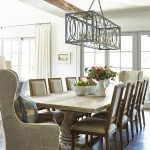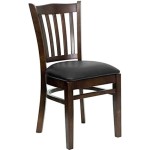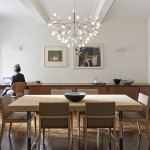Chandeliers For Small Dining Rooms: Illuminating Intimacy
The dining room, regardless of its dimensions, serves as a central gathering space within a home. It's a place for meals shared with family and friends, conversations sparked by the day's events, and memories created around the table. In smaller dining rooms, optimizing space while maintaining an aesthetically pleasing and functional atmosphere is crucial. Chandeliers, often associated with grand ballrooms and expansive estates, might seem counterintuitive for a smaller dining area. However, with careful consideration of size, style, and placement, a chandelier can be a transformative element, adding elegance and sophistication without overwhelming the space.
Choosing the right chandelier for a small dining room involves a more nuanced approach than simply selecting a smaller version of a large-scale design. Factors such as ceiling height, table size, and the overall design aesthetic of the room should be taken into account. Overly large chandeliers can visually shrink the room, making it feel cramped and unbalanced. Conversely, a chandelier that is too small can appear insignificant and underpowered, failing to provide adequate illumination and visual impact. This article explores the key considerations in selecting and installing chandeliers for smaller dining rooms, offering guidance on creating a harmonious and inviting space.
Sizing and Scale: Creating Visual Harmony
Determining the appropriate size of a chandelier for a small dining room is paramount. A general rule of thumb involves calculating the diameter of the chandelier based on the dimensions of the room. To determine the ideal diameter in inches, add the length and width of the room in feet. For example, a dining room measuring 10 feet by 12 feet would suggest a chandelier with a diameter of approximately 22 inches (10 + 12 = 22). This calculation provides a starting point, but adjustments may be necessary based on other factors.
Ceiling height significantly impacts the perceived scale of a chandelier. In rooms with standard 8-foot ceilings, flush mount or semi-flush mount chandeliers are often the most appropriate choice. These fixtures sit closer to the ceiling, preventing the chandelier from feeling overwhelming or obstructing views. For rooms with slightly higher ceilings (9-10 feet), a chandelier with a shorter chain or stem can be used. The bottom of the chandelier should hang approximately 30-36 inches above the dining table to ensure adequate headroom and prevent visual obstruction during meals. If the ceiling height permits, adjusting the chain or stem length during installation allows for customization.
The size and shape of the dining table should also influence the selection of the chandelier. A round table typically pairs well with a round or circular chandelier, while a rectangular table benefits from a linear or oblong chandelier. The width of the chandelier should be approximately one-half to two-thirds the width of the table. This proportion creates a visual balance that complements the table without overshadowing it. Ignoring the table's dimensions can lead to an imbalanced aesthetic, where the chandelier either appears too small and insignificant or too large and imposing.
Style and Design: Complementing the Room's Aesthetic
Beyond size, the style of the chandelier should complement the overall design aesthetic of the dining room. In contemporary spaces, sleek and minimalist chandeliers with clean lines and geometric shapes often work best. These designs typically feature materials such as polished chrome, brushed nickel, or matte black, reflecting the modern sensibility. Crystal chandeliers, while often associated with traditional styles, can also be incorporated into contemporary spaces, provided they feature a streamlined design and avoid excessive ornamentation.
For traditional dining rooms, chandeliers with more ornate detailing, such as curved arms, crystal pendants, and intricate metalwork, can enhance the classic ambiance. Materials like antique brass, oil-rubbed bronze, and wrought iron are common choices for traditional chandeliers. In farmhouse or rustic dining rooms, chandeliers with a more natural and weathered appearance are often preferred. These fixtures may incorporate materials such as wood, rope, or reclaimed metal, adding a touch of organic warmth to the space.
The color palette of the dining room should also be considered when selecting a chandelier. A chandelier with a contrasting color can serve as a focal point, adding visual interest to the room. Conversely, a chandelier that blends seamlessly with the existing color scheme can create a more cohesive and harmonious look. For example, in a dining room with neutral walls and furniture, a chandelier with a pop of color, such as a vibrant turquoise or a deep crimson, can add a touch of personality and flair. Alternatively, a chandelier in a similar neutral tone can create a more subtle and understated elegance.
Light and Functionality: Ensuring Adequate Illumination
The primary function of a chandelier is to provide illumination. While aesthetic considerations are important, the chandelier should effectively light the dining table and the surrounding area. The type and number of light bulbs used in the chandelier directly impact the level and quality of light produced. LED bulbs are often preferred due to their energy efficiency, long lifespan, and versatility in terms of color temperature. Dimmable LED bulbs allow for adjustable lighting levels, creating different moods and atmospheres for various occasions.
The color temperature of the light bulbs significantly affects the ambiance of the dining room. Warm white light (2700-3000K) creates a cozy and inviting atmosphere, ideal for intimate dinners and casual gatherings. Cool white light (4000-5000K) provides a brighter and more energizing light, suitable for tasks such as reading or playing games. The choice of color temperature depends on the desired mood and the intended use of the dining room. In many cases, a warm white light is preferred for dining rooms, as it creates a more relaxing and welcoming environment.
In addition to the chandelier, consider incorporating other light sources into the dining room to create a layered lighting scheme. Recessed lighting can provide ambient illumination, while wall sconces or table lamps can add accent lighting and highlight specific features of the room. A layered lighting scheme allows for greater flexibility in controlling the overall brightness and atmosphere of the dining room. By combining different types of lighting, it is possible to create a space that is both functional and aesthetically pleasing. For example, dimming the chandelier and turning on wall sconces can create a more intimate and romantic atmosphere for a special occasion. The versatility of a layered lighting scheme makes it a valuable asset in any dining room, regardless of size.
Furthermore, the position of the chandelier is critical for optimal lighting. Centering the chandelier over the dining table ensures balanced illumination and prevents shadows from being cast on diners. Incorrect placement can result in uneven lighting, creating an uncomfortable and uninviting atmosphere. Prior to installation, carefully measure the dimensions of the table and the location of the electrical box to ensure accurate placement. Adjustments may be necessary based on the specific layout of the dining room and the desired aesthetic.
The material of the chandelier also influences the quality of light. Chandeliers with clear glass or crystal components allow for maximum light transmission, creating a brighter and more vibrant atmosphere. Chandeliers with opaque or colored shades diffuse the light, creating a softer and more diffused glow. The choice of material depends on the desired level of brightness and the overall aesthetic of the dining room. Consider the existing lighting in the room and the amount of natural light available when selecting a chandelier with specific light-diffusing properties. A well-chosen chandelier can not only provide adequate illumination but also enhance the visual appeal of the space, creating a more inviting and comfortable environment.
Ultimately, the key to selecting the perfect chandelier for a small dining room lies in careful consideration of size, style, and functionality. By thoughtfully assessing the dimensions of the room, the existing décor, and the desired lighting effects, it is possible to find a chandelier that enhances the space without overwhelming it. A well-chosen chandelier can transform a small dining room into a stylish and inviting space, perfect for creating lasting memories with family and friends.

20 Dining Room Lighting Ideas Light Fixtures For Every Style Hgtv

Best Dining Room Lighting Ideas You Ll Want To Copy Farmhousehub

How To Choose The Perfect Dining Room Light Fixture Graham S Living

29 Small Dining Room Lighting Ideas For Superior Illumination

300 Best Dining Room Lighting Ideas In 2025

How To Select The Perfect Dining Room Chandelier Ideas Advice Lamps Plus

Buy The Latest Unique Chandeliers Pendants Online My Lighting Home

Top 40 Dining Room Lighting Ideas With Examples Froy Com

10 Of The Best Vaulted Ceiling Lighting Ideas Lightopia

30 Best Dining Room Light Fixtures Chandelier Pendant Lighting For Ceilings








